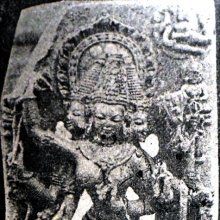Shumbha, Sumbha, Śumbha: 18 definitions
Introduction:
Shumbha means something in Buddhism, Pali, Hinduism, Sanskrit, Marathi, Jainism, Prakrit. If you want to know the exact meaning, history, etymology or English translation of this term then check out the descriptions on this page. Add your comment or reference to a book if you want to contribute to this summary article.
Shumbha has 17 English definitions available.
The Sanskrit term Śumbha can be transliterated into English as Sumbha or Shumbha, using the IAST transliteration scheme (?).
Images (photo gallery)
Languages of India and abroad
Sanskrit dictionary
[Deutsch Wörterbuch]
Source: Cologne Digital Sanskrit Dictionaries: Böhtlingk and Roth Grosses Petersburger WörterbuchŚumbha (शुम्भ):—m. Nomen proprium eines Asura [Harivaṃśa 3262. 9398. 10247.] [Rāmāyaṇa.7,6,35.] [Mārkāṇḍeyapurāṇa 21,35. 90,1. fgg.] [Bhāgavatapurāṇa.8,10,21. 30.] [Weber’s Verzeichniss No. 540.] [Oxforder Handschriften 23,b,2. 46,b,27. 346,a,30.] [Mṛcchakaṭikā 105,22] im Prākrit. Beinn. der Durgā: hananī [Harivaṃśa 9424.] mathanī (mardinī v. l.) [Hemacandra’s Abhidhānacintāmaṇi 205.] ghātinī [Śabdaratnāvalī im Śabdakalpadruma] Vgl. ni .
--- OR ---
Sumbha (सुम्भ):—m. pl. Nomen proprium eines Volkes [Rāmāyaṇa 4, 40, 25.] sg. Nomen proprium eines Landes [Śabdaratnāvalī im Śabdakalpadruma]
Sanskrit, also spelled संस्कृतम् (saṃskṛtam), is an ancient language of India commonly seen as the grandmother of the Indo-European language family (even English!). Closely allied with Prakrit and Pali, Sanskrit is more exhaustive in both grammar and terms and has the most extensive collection of literature in the world, greatly surpassing its sister-languages Greek and Latin.
See also (Relevant definitions)
Starts with: Shumbhadesha, Shumbhaghatini, Shumbhahanani, Shumbhaka, Shumbhamana, Shumbhamarddini, Shumbhamardini, Shumbhamathani, Shumbhana, Shumbhanishumbha, Shumbhapura, Shumbhapuri, Shumbhavadha.
Ends with: Kusumbha, Nishumbha, Shumbhanishumbha.
Full-text (+57): Shumbhaghatini, Shumbhapura, Nishumbha, Dhumralocana, Shumbhanishumbha, Shumbhadesha, Shumbhamarddini, Gundem, Shumbhamardini, Sumbhatara, Nishumbhamardini, Nishumbhamathani, Shumbhavadha, Shumbhahanani, Sambharaja, Shumbhamathani, Cumpan, Cumpattanam, Sumba, Nicumpam.
Relevant text
Search found 34 books and stories containing Shumbha, Sumbha, Śumbha, Sumbhā, Ṣumbha, Suṃbha, Suṃbhā, Śumbhā, Śuṃbha; (plurals include: Shumbhas, Sumbhas, Śumbhas, Sumbhās, Ṣumbhas, Suṃbhas, Suṃbhās, Śumbhās, Śuṃbhas). You can also click to the full overview containing English textual excerpts. Below are direct links for the most relevant articles:
The Markandeya Purana (Study) (by Chandamita Bhattacharya)
5. Origin of Caṇḍikā Śakti < [Chapter 3]
3. Birth of Ambikā / Kauśikī out of Pārvati’s body < [Chapter 3]
Śaktism (worship of Śakti as the female goddess) < [Chapter 4]
Chaitanya Bhagavata (by Bhumipati Dāsa)
Verse 3.2.276 < [Chapter 2 - Description of the Lord’s Travel Through Bhuvaneśvara and Other Placesto Jagannātha Purī]
Verse 2.10.100 < [Chapter 10 - Conclusion of the Lord’s Mahā-prakāśa Pastimes]
The Padma Purana (by N.A. Deshpande)
Chapter 16 - Jālandhara Gives up His Disguise < [Section 6 - Uttara-Khaṇḍa (Concluding Section)]
Chapter 18 - Jālandhara Is Killed < [Section 6 - Uttara-Khaṇḍa (Concluding Section)]
Chapter 101 - The Fight Goes On < [Section 6 - Uttara-Khaṇḍa (Concluding Section)]
The Skanda Purana (by G. V. Tagare)
Chapter 24 - Greatness of Kātyāyanī < [Section 3 - Arbuda-khaṇḍa]
Chapter 19 - The Fail of Vīrabhadra < [Section 4 - Kārttikamāsa-māhātmya]
Chapter 20 - Viṣṇu Fights with Daityas < [Section 2 - Kaumārikā-khaṇḍa]
The Indian Buddhist Iconography (by Benoytosh Bhattachacharyya)
Figure 249 - Dacca image of Khadiravaṇī Tārā
Figure 180-183 - Emanations of Ratnasambhava: Vajratārā and Puṣpatārā
The Markandeya Purana (by Frederick Eden Pargiter)





